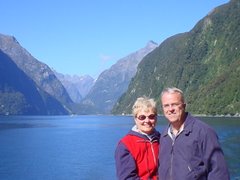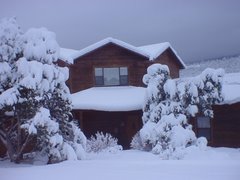Got to the parking lot, which is at the site of a former fort in the crater, not long after sunrise, but lots of folks had been out there for sunrise. It's a hike of .8 miles, one way, including about 250 stairs and a tunnel near the top. At the top is a four-level pillbox of (long-abandoned) gun emplacements, built about 100 years ago. Never used in anger. Fodor's said this is the way to get a great aerial view of Waikiki without having to hire a helicopter. See. (My camera was shaking in the wind, but at least didn't blow off the shelf I sat it on.)

We had a lovely anniversary brunch in our hotel's restaurant (rated as one of the best Hawaiian places for breakfast) and then did some semi-random touring of Honolulu today.
Inland from the hotel you can see several residential areas marching up the side of the steep hills that encircle the city. We wound our way up to the top of one area, with this view of the city below.

New England missionaries arrived in Hawaii in 1820 and the place has never been the same since. Better or worse? is the issue. This source on state history says: "It is difficult to find an objective Hawaiian history that is accurate and unemotional." The Hawaiian Roots website summarizes it thus: "When the missionaries arrived in Hawaii in 1820, the Hawaiian people had already dismantled their heiaus and had rejected their religious beliefs. From 1837 to 1840, nearly 20,000 Hawaiians finally chose to accept Christianity as their new religion.
"The missionaries who came to Hawaii in the earliest years were a majority from puritan New England, which explains much about their character. The missionaries reduced the Hawaiian language to written form, enabling the Hawaiian people to read and write in their own language. Schools were established throughout the islands as rapidly as possible. By 1831, only 11 years after the missionaries' arrival, some 52000 pupils had been enrolled. The missionaries introduced western medicine and undertook the Kingdom's first modern census. And the missionaries are credited to helping Hawaii become and remain an independent nation at a time when Hawaii was ripe for colonization."
Just wanting to get a little feeling for this history, we next found our way downtown to the Missionary Houses Museum. We found that the only way to see the inside of the houses was to take a guided 1.75 hr. tour and the next one was not scheduled for another hour. Decided not to wait, so we just got a photo of the houses (some of which were pre-fabbed in New England and shipped to Hawaii) and also one of the nearby statue of King Kamehameha I (the Great).

King K the Great, helped by arms he got from the European discoverer of Hawaii, Captain Cook, united the Hawaiian islands in 1810. He died in 1819.

Next stop on our historical tour was the Queen Emma Summer Palace.

Turned out that this was another pre-fabbed New England house that subsequently became the property of King Kamehameha IV and his wife, Emma. And here we lucked out. Got a guided tour by a very enthusiastic and informative guide.
Emma, picture below, was Hawaiian royalty (lineage connected back to K the Great), 3/4 native Hawaiian, 1/4 British. She and the King had one son who died at four years old and the King himself (Kamehameha, not Elvis, also big here) died just a year later. (The King was an advocate of better health care for the islanders, proof, our guide said, that Hawaiians were way ahead of the US. ) In spite of her short tenure as queen, as the above link says, she became "one of the most influential figures in Hawaiian history. Once a candidate for the royal throne, Emma became known and loved for her humanitarian efforts throughout the Islands." She traveled to the US and England, became a friend of Queen Victoria, and raised money for an Anglican cathedral and girls school in Honolulu. She did run unsuccessfully to succeed King K V, the brother or cousin who had succeeded her husband. She died in 1885 at the age of 49.

In the early 1900s the summer palace (which was used for social occasions, not as a residence) was about to be demolished, but was saved for preservation by the Daughters of Hawaii. This group was founded by seven daughters of missionaries "to perpetuate the memory and spirit of old Hawaiʻi and of historic facts, and to preserve the nomenclature and correct pronunciation of the Hawaiian language." The interior of the summer palace is decorated with a lot of period art and furniture.
One sidebar from our guide. There were attempts to increase trade with the US, primarily in sugar, in the mid-1800s, but these were resisted by Hawaiian leadership because they feared it would bring slavery to Hawaii. It was some time later, after the end of the monarchy -- they ran out of heirs, our guide said, contrary to the standards and practices of British counterparts -- that trade with the US took off and, of course, Hawaii became a US territory and eventually a state.
Frances Sumner, mother of Valerie Easterling, said she once lived somewhere up Booth Street in Honolulu, so we decided to find the street. (We've found it fun in our travels to look up the roots of friends and family.) Booth Street was in the same general area as Emma's palace, so with a very helpful hand from Verizon's GPS we found it. Here's what the street looks like today. Finally dead-ends just beyond this.

We have no idea where Frances lived, but these looked like they could be WWII era bungalows.

After all this historical stuff, we headed downtown looking for Starbucks and a book store. Pulled into the parking lot of a downtown mall that looked promising, but it wasn't. Nevertheless, the mall happened to be the home of the legendary Don Ho's Island Grill, so we had a lovely anniversary late lunch there. Finished the day later with another sunset watch outside our hotel.


After all this historical stuff, we headed downtown looking for Starbucks and a book store. Pulled into the parking lot of a downtown mall that looked promising, but it wasn't. Nevertheless, the mall happened to be the home of the legendary Don Ho's Island Grill, so we had a lovely anniversary late lunch there. Finished the day later with another sunset watch outside our hotel.

Cheers,
Susie and Rob







No comments:
Post a Comment